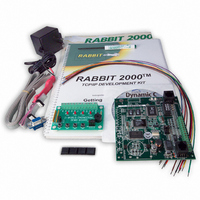101-0401 Rabbit Semiconductor, 101-0401 Datasheet - Page 70

101-0401
Manufacturer Part Number
101-0401
Description
KIT DEV RABBIT2000/TCP/IP
Manufacturer
Rabbit Semiconductor
Series
RabbitCore 2000r
Type
MPU Moduler
Datasheet
1.101-0402.pdf
(82 pages)
Specifications of 101-0401
Rohs Status
RoHS non-compliant
Contents
Rabbit 2000™ TCP/IP Development Board, Demo Board, Power Supply, Cable and Software
Processor To Be Evaluated
Rabbit 2000
Interface Type
RS-232, RS-485
For Use With/related Products
RCM2000, RCM2010, RCM2020
Lead Free Status / Rohs Status
Lead free / RoHS Compliant
Other names
101-0401
316-1005
Q906133
316-1005
Q906133
B.3 Chip Select Circuit
Figure B-6 shows a schematic of the chip select circuit.
W
W
W
W
Figure B-6. Chip Select Circuit
The current drain on the battery in a battery-backed circuit must be kept at a minimum.
When the TCP/IP Development Board is not powered, the battery keeps the SRAM mem-
ory contents and the real-time clock (RTC) going. The SRAM has a powerdown mode that
greatly reduces power consumption. This powerdown mode is activated by raising the
chip select (CS) signal line. Normally the SRAM requires Vcc to operate. However, only
2 V is required for data retention in powerdown mode. Thus, when power is removed from
the circuit, the battery voltage needs to be provided to both the SRAM power pin and to
the CS signal line. The CS control circuit accomplishes this task for the CS signal line.
In a powered-up condition, the CS control circuit must allow the processor’s chip select
signal /CS1 to control the SRAM’s CS signal /CSRAM. So, with power applied, /CSRAM
must be the same signal as /CS1, and with power removed, /CSRAM must be held high
(but only needs to be battery voltage high). Q5 and Q6 are MOSFET transistors with
opposing polarity. They are both turned on when power is applied to the circuit. They
allow the CS signal to pass from the processor to the SRAM so that the processor can peri-
odically access the SRAM. When power is removed from the circuit, the transistors will
turn off and isolate /CSRAM from the processor. The isolated /CSRAM line has a 100 k
pullup resistor to VRAM (R29). This pullup resistor keeps /CSRAM at the VRAM voltage
level (which under no power condition is the backup battery’s regulated voltage at a little
more than 2 V).
TCP/IP Development Kit
66













